Design and description
The Iris-class ships were designed as dispatch vessels and were later redesignated as second-class protected cruisers. Iris had an overall length of 331 feet 6 inches (101 m), a beam of 46 feet (14 m), and a draught of 20 feet 6 inches (6.2 m). They displaced 3,730 long tons (3,790 t ) at normal load [1] and were the first British warships with an all-steel hull. [2] Their crew consisted of 275 officers and ratings. [1]
The Iris class was powered by a pair of horizontal four-cylinder Maudslay, Sons and Field compound-expansion steam engines, each driving one propeller shaft using steam from eight oval and four cylindrical boilers. [1] The engines were designed to produce a total of 6,000 indicated horsepower (4,500 kW ) for a speed of 17 knots (31 km/h; 20 mph). Iris initially reached a maximum speed of 16.6 knots (30.7 km/h; 19.1 mph) from 7,086 ihp (5,284 kW) during her sea trials, but after new propellers were fitted, achieved 17.89 knots (33.13 km/h; 20.59 mph) from 7,330 ihp (5,470 kW). [3] The ship carried enough coal to steam 4,400 nautical miles (8,100 km; 5,100 mi) at 10 knots (19 km/h; 12 mph). She was initially fitted with a barque sailing rig, but this was removed after a few years. [1]
The Iris-class ships were originally armed with ten 64-pounder (6.3-inch (160 mm)) rifled muzzle-loading (RML) guns, eight on the main deck and the remaining pair on the upper deck on pivot mounts to serve as chase guns fore and aft. [1]

HMS Dreadnought was an ironclad turret ship built for the Royal Navy during the 1870s. Construction was halted less than a year after it began and she was redesigned to improve her stability and buoyancy. Upon completion in 1879, the ship was placed in reserve until she was commissioned in 1884 for service with the Mediterranean Fleet. Upon her return 10 years later, she became a coast guard ship in Ireland for two years. The ship then became a depot ship in 1897 before she was reclassified as a second-class battleship in 1900. Dreadnought participated in the annual fleet manoeuvres for the next two years before she became a training ship in 1902. The ship was taken out of service three years later and sold for scrap in 1908.

HMS Galatea was one of eight Arethusa-class light cruisers built for the Royal Navy in the 1910s. She fought in the First World War, participating in the Battle of Jutland. Following the war, she was scrapped.
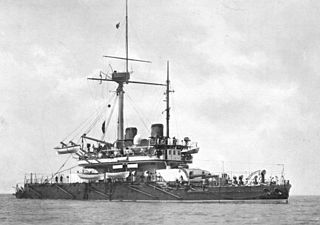
HMS Thunderer was one of two Devastation-class ironclad turret ships built for the Royal Navy in the 1870s. She suffered two serious accidents before the decade was out and gained a reputation as an unlucky ship for several years afterward. The ship was assigned to the Mediterranean Fleet in 1878 and was reduced to reserve in 1881 before being recommissioned in 1885. Thunderer returned home in 1887 and was again placed in reserve. She rejoined the Mediterranean Fleet in 1891, but was forced to return to the UK by boiler problems the following year. The ship became a coast guard ship in Wales in 1895 and was again placed in reserve in 1900. Thunderer was taken out of service in 1907 and sold for scrap in 1909.

HMS Southampton was a Town-class light cruiser built for the Royal Navy in the 1910s. She was a member of the Chatham sub-class of the Town class. The ship survived the First World War and was sold for scrap in 1926.
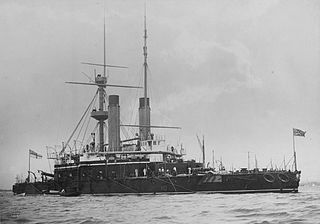
HMS Nile was one of two Trafalgar-class ironclad battleships built for the Royal Navy during the 1880s. Late deliveries of her main guns delayed her commissioning until 1891 and she spent most of the decade with the Mediterranean Fleet. Nile returned home in 1898 and became the coast guard ship at Devonport for five years before she was placed in reserve in 1903. The ship was sold for scrap in 1912 and broken up at Swansea, Wales.

HMS Inconstant was an unarmored, iron-hulled, screw frigate built for the Royal Navy in the late 1860s. Upon completion in 1869, she was the fastest warship in the world and was assigned to the Channel Squadron. Two years later the ship was transferred to the Detached Squadron for a brief time before she was paid off into reserve in 1872. Inconstant was recommissioned in 1880 for service with the Flying Squadron that circumnavigated the world in 1880–82. On the return voyage, the ship was diverted to Egypt during the Anglo-Egyptian War of 1882 and played a minor role supporting operations ashore. She was reduced to reserve again after her return and was served as an accommodation ship in 1897. Inconstant was hulked in 1904 and became a training ship in 1906. She continued in that role, under a variety of names, until she was sold for scrap in 1955 and subsequently broken up, the second-to-last surviving Pembroke-built warship in existence.

HMS Aurora was one of seven Orlando-class armoured cruisers built for the Royal Navy in the mid-1880s. The ship spent a brief time in reserve before she was assigned to the Channel Squadron for two years in 1890. In 1893 Aurora became a coast guard ship in Ireland for two years before she was placed in reserve again. The ship recommissioned in 1899 for service on the China Station and some of her crew participated in the Battle of Tientsin in 1900 during the Boxer Rebellion. Aurora returned home two years later and was again reduced to reserve. She was taken out of service in 1905 and sold for scrap on 2 October 1907.
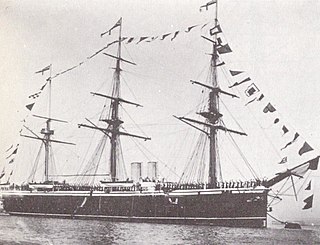
HMS Northampton was a Nelson-class armoured cruiser built for the Royal Navy in the 1870s. She was sold for scrap in 1905.

HMS Inconstant was one of eight Arethusa-class light cruisers built for the Royal Navy in the 1910s. She fought in the First World War, participating in the Battle of Jutland. Following the war, she was scrapped.

HMS Phaeton was one of eight Arethusa-class light cruisers built for the Royal Navy in the 1910s. She fought in the First World War, participating in the Battle of Jutland. Following the war, she was scrapped.
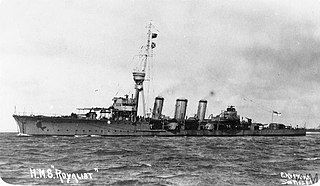
HMS Royalist was one of eight Arethusa-class light cruisers built for the Royal Navy in the 1910s. She fought in the First World War, participating in the Battle of Jutland. Following the war, she was scrapped.

HMS Undaunted was one of eight Arethusa-class light cruisers built for the Royal Navy in the 1910s.

HMS Forward was the name ship of her class of two scout cruisers built for the Royal Navy in the first decade of the 20th century. The ship was in reserve for most of the first decade of her existence. After the beginning of the First World War in August 1914, she was assigned to coastal defence duties on the East Coast of England. Forward was present when the Germans bombarded Hartlepool in mid-December 1914, but played no significant role in the battle. The ship was sent to the Mediterranean in mid-1915 and was then assigned to the Aegean Sea a year later, together with her sister ship, Foresight, and remained there until the end of the war. After returning home in 1919, she was sold for scrap in 1921.

HMS Foresight was one of two Forward-class scout cruisers built for the Royal Navy during the first decade of the 20th century. The ship was in reserve for most of the first decade of her existence. After the beginning of the First World War in August 1914, she was initially assigned to the Dover Patrol and was then transferred to the 8th Destroyer Flotilla. Foresight was sent to the Mediterranean in mid-1915 and was then assigned to the Aegean Sea a year later, together with her sister ship, Forward, and remained there until the end of the war. After returning home in 1919, she was sold for scrap in 1920.

HMS Adventure was the name ship of her class of two scout cruisers built for the Royal Navy during the first decade of the 20th century. For two years after being completed in 1905, the ship was in reserve. She was commissioned in mid-1907 as a flotilla leader in the Home Fleet. When the First World War began in August 1914, she was assigned to patrol the English Channel. In mid-1915 Adventure was transferred to Irish waters to serve as the flagship there. In early 1918, the ship escorted convoys to Gibraltar before being transferred to the Mediterranean at the end of the war. She returned home in mid-1919 and was paid off. Adventure was sold for scrap in early 1920.

HMS Attentive was one of two Adventure-class scout cruisers built for the Royal Navy during the first decade of the 20th century. Completed in 1905 the ship was placed in reserve until she was commissioned in 1907 as part of the Home Fleet. She then spent the next seven years moving on and off of active service in British waters. The ship sank one destroyer and damaged two others in collisions. Attentive was assigned to coastal defence duties when the First World War began in 1914, and spent most of the war assigned to the Dover Patrol. She played a minor role in the Zeebrugge Raid in early 1918 and was then assigned to escort convoys to Gibraltar. The ship was sent to the White Sea later in the year to support the unsuccessful North Russia intervention in the Russian Civil War. Attentive paid off at the end of 1918 and was sold for scrap in 1920.

The Iris class consisted of two ships, HMS Iris and HMS Mercury, built for the Royal Navy in the 1870s. They were the first British all-steel warships.

HMS Mercury was one of two Iris-class despatch vessels, later redesignated as second class cruiser built for the Royal Navy during the 1870s. The two ships were the first all-steel warships in the Royal Navy.

The Topaze-class cruisers were a quartet of third-class protected cruisers built for the Royal Navy in the first decade of the 20th century. HMS Amethyst of this class was the first warship larger than a destroyer to be powered by turbine engines.
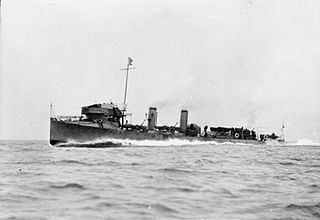
The Cricket class and following classes of coastal destroyers were a series of small torpedo boat destroyers (TBDs) intended to complement the Royal Navy's Tribal-class destroyers. The thirty-six vessels which broadly comprised this group actually consisted of several distinct classes, as each contractor built to their own designs, and even single contractor's designs evolved from year to year.




















